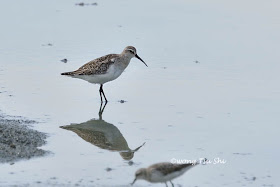Positive field identification of swiftlets is a real difficult thing to do, and with this latest split of montane Bornean Swiftlet Collocalia dodgei from Glossy Swiftlet C. esculenta (to some authority, Linchi Swiftlet C. linchi) (the lowland form of which also occur in montane habitats in Borneo), there will be endless arguments as to which is Bornean and which is Glossy.
Before this, Smythies (1999) as revised by G W H Davison listed this a White-bellied Swiftlet, with the montane Mt. Kinabalu form as C. esculenta dodgei and lowland form as C. e. cyanoptila. No Linchi Swiftlet from Smythties at that time due to confusions in physical characteristics to separate the two forms.
Moyle
et al. (2008) split Bornean Swiftlet from Linchi Swiftlet
C. linchi, itself a split from Glossy Swiftlet
C. esculenta, based on a comparison of molecular data obtained from two specimens of 'unknown identity (but presumably
dodgei)' from Mt. Kinabalu, Sabah, and data from another study (Price
et al. 2004) relating to the specimen of
linchi from Java.
Moyle collected 3 individuals of
C. esculenta cyanoptila from c.1500 m on the south side of Mt Kinabalu and 2 nestlings close to fledging (of unknown identity, presumed
C. dodgei) from c.2730 m, also on the south side of Mt Kinabalu. The putative
C. dodgei fledglings lacked the feather tuft on the hind toes, had white bellies and showed upperparts to be dark brown with a faint green gloss. The nest from which they were removed was built of rootlets, plant fibres and lichens attached to a beam in a hut on two sides with hardened saliva.
Moyle
et al. summarise by saying;
Linchi Swiftlet
C. linchi has a restricted distribution on various Sundaic islands and has a grey belly.
Bornean Swiftlet
C. dodgei is differentiated by molecular data and in morphology, white belly and is a montane species.
Mann (2008) in his checklist of Borneo recognised this montane form as a distinct species but uses the name Linchi swiftlet
C. linchi for this species.
Both Phillipps (2009) and Myers (2009) follow Moyle in their fieldguides for Birds of Borneo and listed this as Bornean swiftlet
Collocalia dodgei.
These pictures were taken at montane altitudes, at about 1,600 meters showing what I assume to be Glossy Swiftlets. (Bear in mind that they are split based on DNA and not by physical appearance, physical feather color like bluish or greenish gloss and feather on hind toe are too environmental and moult dependent to be of real help in field identification.)
This might not be Bornean is also reinforced by the fact that the Bornean Swiftlets were collected at much higher altitude at Layang-layang by Moyle.
Taken in Gunung Alab Resort in 2009
Taken in Gunung Alab Resort in 2010
Taken in Gunung Alab Resort in 2009
Taken near Kinabalu Park HQ, these birds must be Glossy as birds near Park HQ have been established to be Glossy and not Bornean.
Happy birding.



















































